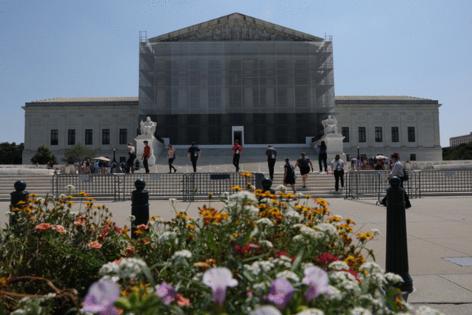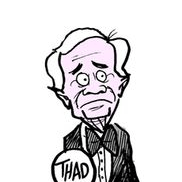Noah Feldman: Supreme Court's porn ruling continues the conservative revolution
Published in Op Eds
In a landmark 6-3 decision, the Supreme Court upheld age-verification requirements for accessing online pornography sites, effectively overturning a precedent that had stood for more than 20 years. Alongside its January decision on TikTok, the ruling marks a new era in the court’s online First Amendment jurisprudence: the justices are increasingly willing to uphold government suppression of free speech for policy reasons.
The opinion in the case, Free Speech Coalition v. Paxton, was written by Justice Clarence Thomas, who, until recently, was something of a free speech absolutist. Thomas made it extremely clear that his goal was to find a way to uphold the Texas age-verification law at issue, regardless of precedent.
He had little choice but to acknowledge that in a 2004 case, Ashcroft v. American Civil Liberties Union (known as Ashcroft II), the court had struck down a federal law requiring age verification to access online porn. But things had changed since then, he wrote:
With the rise of the smartphone and instant streaming, many adolescents can now access vast libraries of video content—both benign and obscene—at almost any time and place, with an ease that would have been unimaginable at the time of … Ashcroft II.
It’s worth noting that Thomas and the other conservatives on the Court — all supposedly committed originalists — were prepared to cite evolving technology as a basis for changing First Amendment law. Meanwhile, the court’s three liberals, in a dissent written by Justice Elena Kagan, focused on consistency with precedent.
This is what jurisprudence looks like when a conservative constitutional revolution is underway. The conservative majority can openly admit to the need to keep the law updated, while liberals insist on the value of precedent, because conservatives are happily breaking it.
To reach his desired result, Thomas had to engage in some pretty questionable legal reasoning that, if taken seriously in other contexts by the court, could shift some of the cornerstones of free-speech law.
In 2004, when evaluating the federal age-verification law that Kagan justifiably likened to a “near twin” of the Texas law, the Supreme Court applied strict scrutiny, the most rigorous form of constitutional review. Essentially, when a law burdens otherwise protected speech, it will be found unconstitutional unless the government has a compelling interest and has adopted the least restrictive means to achieve it.
In the 2004 Ashcroft II case, the court held that because age verification imposed a burden on adults’ ability to access material protected under the First Amendment, the law must be subject to strict scrutiny. The court acknowledged that protecting minors from material that would be considered obscene from their perspective was a compelling government interest. However, it held that the law still failed to satisfy strict scrutiny because the government had not demonstrated that the age-verification requirements, as they existed at the time, were the least restrictive means of achieving its goal.
Thomas could have written the opinion to say that age verification does satisfy strict scrutiny today, either because age-verification technology has improved, or that alternative solutions have failed to emerge. Kagan, for her part, took pains to say that this course of action would have been a plausible one.
But Thomas didn’t want to say that because it would have required the court to look in detail at how the age-verification provision would function in the real world. Such an analysis might well have shown that the requirement would deter a meaningful number of adults from viewing porn sites — which would have made it difficult to conclude that the age-verification regime is in fact the least restrictive means of protecting minors.
So, Thomas instead attempted to distinguish the Texas law from the federal statute at issue in the 2004 case by asserting that the federal law “banned” speech directly, whereas the Texas law merely imposed an “incidental” burden on accessing protected speech by requiring adults to verify their ages. That distinction is analytically weak, at best. Both laws burden adults’ access to material that is constitutionally protected for them to view.
Worse, Thomas was forced to reinterpret an important precedent defining incidental burdens: a 1968 case called US v. O’Brien, which upheld a law banning the burning of draft cards. According to that case, a law that targets conduct rather than speech is subject to a lower level of review, called intermediate scrutiny. Thomas applied O’Brien to the Texas law, even though the Texas statute is aimed at restricting speech, not conduct.
The takeaway is that the justices think the problem of kids’ access to online porn is serious enough to change the ground rules of First Amendment law. That’s not dissimilar from what happened in the TikTok case, where the justices — including the liberals — deviated from free-speech norms because they were panicked by concerns about China.
Neither case will age well. The very real problem of kids’ access to online pornography is unlikely to be solved by laws like Texas’. Concerns about online privacy and the potential influence of platform owners would not have been solved by the TikTok ban, which, in any case, hasn’t gone into effect because the Trump administration hasn’t enforced it.
The justices do best in free-speech cases when they avoid social panic and stick to principle. That didn’t happen in this case.
____
This column reflects the personal views of the author and does not necessarily reflect the opinion of the editorial board or Bloomberg LP and its owners.
Noah Feldman is a Bloomberg Opinion columnist. A professor of law at Harvard University, he is author, most recently, of “To Be a Jew Today: A New Guide to God, Israel, and the Jewish People."
©2025 Bloomberg L.P. Visit bloomberg.com/opinion. Distributed by Tribune Content Agency, LLC.

























































Comments